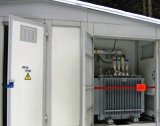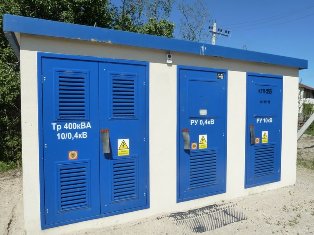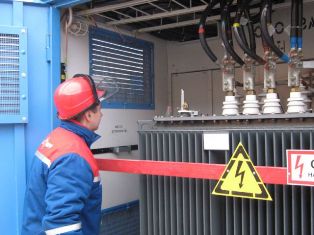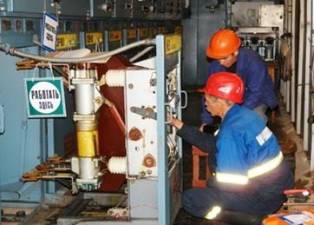Occupational safety of an electrician for the maintenance of transformer substations and distribution points
 Increased labor safety requirements are imposed when working in transformer substations and distribution points. Even before being assigned to self-employment, an electrician must undergo training in safe work methods, occupational safety induction, initial on-the-job instruction, initial knowledge testing of PTB, PTE, fire safety rules and instruction in an amount necessary for the profession, duplicating over several shifts under the guidance of an experienced mentor. And only after passing all stages of training, the electrician can start independent work.
Increased labor safety requirements are imposed when working in transformer substations and distribution points. Even before being assigned to self-employment, an electrician must undergo training in safe work methods, occupational safety induction, initial on-the-job instruction, initial knowledge testing of PTB, PTE, fire safety rules and instruction in an amount necessary for the profession, duplicating over several shifts under the guidance of an experienced mentor. And only after passing all stages of training, the electrician can start independent work.
In the process of work, the electrician for the maintenance of transformer substations and distribution points must undergo repeated briefings (at least 1 time per month), special training (at least 1 time per month), control emergency training (at least 1 time in 3 months ), fire safety control training (at least 1 time every six months), periodic testing of knowledge of PTB, PTE, fire safety rules and instructions (once a year), as well as medical examination — 1 time in 2 years.
Equipment is of great importance. These are special clothing and footwear, a safety helmet, a gas mask, a protective mask or goggles and, if necessary, a seat belt. A special talk about the tools. They must be serviceable and in place.
Tools with insulating handles are subjected to periodic electrical tests during operation. Protective equipment must be tested and stamped with an expiration date. The electrician must remember that his life depends on the performance of devices and tools, overalls and devices.
The site's workshop is a permanent workplace for an electrician. Here you have to maintain order, everything has its place. Before starting work, it is necessary to remove unnecessary objects, adjust the local lighting so that the work area is sufficiently illuminated, but at the same time the light does not blind the eyes.

The main work that is done at the transformer substation is planned prevention, periodic and extraordinary inspections. Most of the preventive maintenance and repair of transformer substations and distribution points is performed with the electrical equipment turned off.
These works require careful preparation of the workplace, where organizational and technical measures must be taken to ensure the safe execution of the work. For this, the master prepares equipment with the appointment of persons responsible for the safe execution of the work. Depends electrical safety groups, experience, experience in electrical installation and circuit complexity, an electrician may be assigned as a receptionist, job supervisor, or team member.
The permittee or the producer of the work received equipment from the captain or a verbal order of the signs to the brigade with the content of the work, depending on which the necessary overalls, protective equipment, tools, devices and materials were selected. Having prepared everything necessary, the team goes to work place.
Upon arrival at the site, the team receives permission to prepare the workplace and for admission from the duty officer. Under no circumstances should such permission be given in advance. Permission to prepare a workplace and for admission is drawn up in a work order. The preparation of the workplace is carried out by the host together with the producer of the work.
To prepare the workplace during work requiring voltage relief, it is necessary to carry out the switches indicated in the order in the electrical installation. In electrical installations, on each side from which voltage can be applied to the workplace, a gap formed by the disconnection of busbars and wires, the disconnection of switching devices, the removal of fuses must be visible. All trips here take place in dielectric gloves.
Fuses must be removed and installed with the voltage removed, but if the circumstances do not allow this, then it is necessary to use insulating pliers, a bar with gloves and glasses. After switching off the switching equipment, it is necessary to take measures to prevent its spontaneous activation, i.e.

So the tension eases and you can get to work? No. It is necessary to check the serviceability voltage indicator using special devices or live parts known to be live, and then using it again to make sure that there is no live.
In electrical installations with a voltage above 1000 V, it is necessary to use a voltage indicator with dielectric gloves. In electrical installations above 1000 V, it is allowed to check the absence of voltage by one employee from the duty or operational-duty staff with 4 electrical safety group, and in electrical installations up to 1000 V with 3 groups. Here, to check the absence of voltage, you can use a bipolar indicator for phase and line voltage.
The electrical installation is earthed by turning on the earthing switches or by installing a portable earthing. First, they are connected to a grounding device, and then, after checking the absence of voltage, they are installed on live parts.
In electrical installations above 1000 V, the grounding is installed by two workers — one with the 4th electrical safety group among the operating personnel, the other with the 3rd electrical safety group.The use of dielectric gloves and an insulating rod is mandatory! Clamps of portable grounding must be fixed with a stick or directly with hands in dielectric gloves.
They hang on the prepared workplaces posters work here… Remaining live live parts are fenced off and placards «Stop. Voltage».
So, the workplace preparation is over. The initial reception of the brigade according to orders and orders must be done directly here at the workplace. At the same time, the receiver is obliged to check the compliance of the composition of the brigade with that specified in the order according to the personal certificates, to prove the absence of voltage to the brigade by showing grounding or by checking the absence of voltage and then touching the live parts with his hand, if grounding is not visible from the workplace, to conduct a targeted briefing to the work producer, supervisor and crew members, providing instructions for the safe performance of a specific job.
The contractor, in turn, must also provide targeted instruction to team members. Admission to work is prohibited without purposeful briefing and registration in clothing during initial admission. The admission is drawn up by the acceptor and the manufacturer of the article of clothing, indicating the date and time. After acceptance, the supervision of compliance with the safety requirements of the team is assigned to the contractor. He should supervise the crew, if possible, in the area of the workplace where the most dangerous work is being done.

After the full completion of the work, the manufacturer of the work must remove the team from the workplace, together with the one that allows to remove the installed fences, posters, grounding. The full completion of the work is done in the clothing. Then you must inform the employee who issued the permit to prepare the workplace and to allow the full completion of the work so that he can turn on the electrical installation.
The electrical installation is switched on by a person from the operational and operational-repair personnel, who is part of the suction brigade. This can be the author or producer of the work. Then you have to arrive at the control room and hand over the outfit, and at the end of the working day tidy up the workshop and coveralls.
